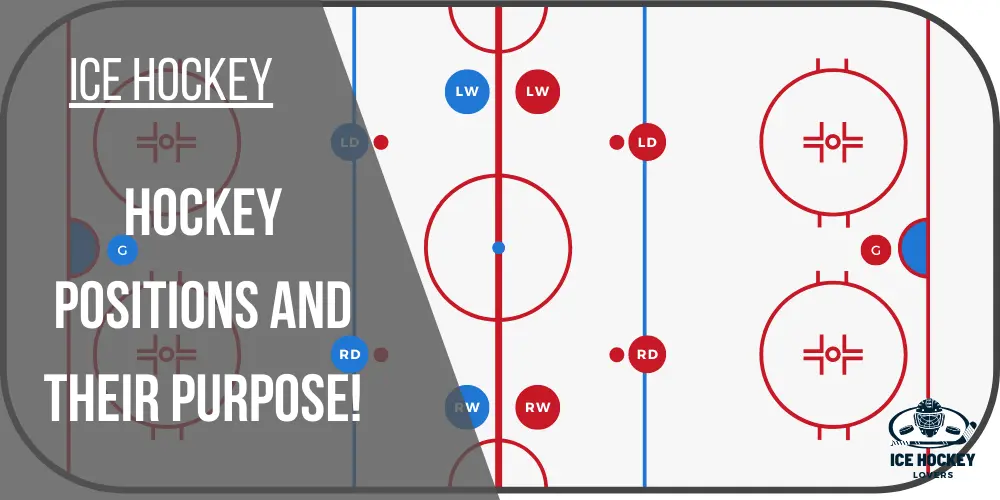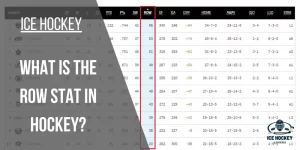The Ultimate Guide to Hockey Positions: A Complete Breakdown!

Hockey is an exhilarating sport that requires teamwork, skill, and strategic thinking. To achieve success on the ice, it is essential for each player to understand their role within the team structure. This is where hockey positions come into play. Each position has specific responsibilities and functions that contribute to the overall performance of the hockey team.
Six players are playing on the ice, and their positions are center, left-wing, and right-wing. These three positions come in the ‘forward category’. Others are left defensemen and right defensemen, and they are in ‘defensemen positions’. The last and sixth player is a goaltender who blocks the shots from getting into the net.
In this article, we will explore the various ice hockey positions, their roles, and the skills required to excel in each position.
Table of Contents
What are the Hockey Positions?
The ice Hockey match arena is set on five player’s positions, but six players are standing on the other team on the ice.
- Forward – 3 Positions
- Center
- Left Wing
- Right Wing
- Defensemen – 2 Positions
- Right Defenseman
- Left Defenseman
- Goalie – Each team has one goalie to stop the coming puck into the net.
Let’s get into the details of the functions of these positions.
Forward Positions
Center
Without a doubt center position in ice hockey is crucial for the whole team, having a strong influence on the offensive zone and directing the games, as well as a key role on the defensive side. Center players’ game sense and vision are of high level, plus with the best stick handling and top-notch puck passing skills, they are the most valuable and high-class players on the team.
Purpose of the Center positioning
The primary task of the center is to win the face-off. Winning a face-off is vital to the opposing offense and gaining puck possession as soon as center players try to take the face-off, their wingers take control of the puck. When the puck is in the offensive zone, center players lead the game by dictating the play and great puck passes.
On the defensive side of the ice, they are responsible for countering the opposing team’s forward man, who is also taking much control of the puck. They are tasked to lock down the defensive zone slot area because they have the most surface area to look after or cover, ranging from their net to the blue line to the face-off dot.
Usually, the most popular Hall of Fame players like Wayne Gretzky and Mario Lemieux are center ones, opposing team’s right defenseman, including the current stars like Sidney Crosby and Connor McDavid.
Left Wing & Right Wing
The left and right two wingers almost have the same roles other than the left side of their standing position. However, there can be variations in their tasks based on the system used.
The highest goal scorers in the team are wingers. They are the leading goal scorers in a hockey arena. The left Winger is great in wrist and slap shots, while the Right Wing is best in sniping corners and playing their master shots. They both are exceptional in using their feet and controlling the puck with sticks, making a way to win the battle against opponents. In addition to these skills, they must understand ice vision well to find a safe place for an open shot.
Purpose of the Left and Right Wing
When the center man takes the puck, he is looking for a winger to pass the puck in a scoring position. They are assigned the right winger to carry the puck on the offensive side and set the game for their other players.
On the wing forwards defensive side, they are responsible for clearing the puck and halting the opposing team captain’s defense from getting into their offensive zone. If the puck gets into control of opponents, they do their best to go down the ice in a chance of a breakout pass. Moreover, wingers stand between the blue line and face-off to guard their team and block the offensive team’s defensemen not letting them play a quality shot.
The left wingman comes with another responsibility in a defensive system known as a left-wing lock. He sometimes stays up high to play along with the left defenseman when another team exiting its defense side gives them a tough time transitioning from defense to offense zone, creating a turnover. The left-wing lock can quickly employ this to have scoring opportunities and chances.
Defense Positions
Left & Right Wingers
Defensemen, as with their name, are to defend their team by preventing opponents from scoring and making it difficult for them to transition from offense to the two defensemen. A good defenseman has a significant ability in reading to guess the game of the opposing team and where the puck is during the entire game. Defensemen have extraordinary skating abilities and are mastered backward skating. They are good at passing and shooting pucks, specifically when making breakout shots.
Purpose of the Left & Right Wingers
To stop the opposing team’s forwards from scoring goals, defensemen work on these four points.
- Blocking of passing and shooting lines: a defenseman tries to stop any pass from getting to the goaltender.
- Interrupt the transition and breakout flow: with stick and body position tactics, they guide the players toward the outside, stopping them from entering the net.
- Taking puck outside of defensive zone: a master defenseman has excellent skills in puck recovering from the hands of the opposing team and quickly skating it out of their zone or passing it toward the forward for an offensive attack.
- Net protecting: defensemen bring the forwards out from the front of the goalie, who is countering the goalie and usually tangles their sticks with opponents by lifting the sticks.
Goaltender Position
The goalie is a crucial player in a team playing defense and plays an essential role in defending and saving his team captains and crew. A team can never play a match without the goalkeeper.
Purpose of the Goaltender Position
They are assigned the goalie’s job as one crucial task: to stop the puck from going into the net by applying any means possible. Goalies almost use all parts of their body to protect their net by preventing the puck even though there are other means to stop the puck, but as it allows them to use their body, they are manageable with that.
To face shots traveling at 100mph isn’t something easy but deadly serious that even Glenn Hull, like legendary goaltender, calls it “60 minutes of hell”
A match win mostly counts on a goalie’s critical saves and sacrifices!
Key Skills and Responsibilities for Each Position
Each hockey position requires specific skills and carries unique responsibilities. Here’s a summary of the key skills and responsibilities for each position:
- Center: Faceoffs, playmaking, offensive and defensive support, strong skating, passing, and shooting skills.
- Left Wing: Goal-scoring, offensive plays, defensive support, agility, accurate shooting, and quick transitions.
- Right Wing: Goal-scoring, offensive plays, defensive support, agility, accurate shooting, and quick transitions.
- Left Defenseman: Defensive plays, offensive support, blocking shots, stick-checking, and positioning.
- Right Defenseman: Defensive plays, offensive support, strong on the puck, decision-making, and powerful shooting from the blue line.
- Goaltender: Stopping shots on goal, reflexes, agility, positioning, communication, and directing the defense.
Strategies and Tactics for Different Positions
Each position has its own strategies and tactics that players need to master. These strategies vary depending on the team’s game plan, the opponent’s style of play, and the specific situation on the ice. Here are some common strategies for different positions in hockey below:
- Centers: Focus on setting up plays, winning faceoffs, and distributing the puck effectively.
- Wingers: Emphasize goal-scoring, creating offensive opportunities, and providing support to the defense.
- Defensemen: Prioritize strong defensive play, initiating offensive plays from the defensive zone, and maintaining good positioning.
- Goaltenders: Concentrate on positioning, tracking the puck, making saves, and communicating with the defense.
Famous Players in Hockey Positions
Each hockey position has seen legendary players who have left a lasting impact on the sport. Their skills, achievements, and contributions have solidified their place in hockey history. Here are some famous players in each position:
- Center: Wayne Gretzky, Mario Lemieux, Sidney Crosby.
- Left Wing: Bobby Hull, Luc Robitaille, Alexander Ovechkin.
- Right Wing: Gordie Howe, Jaromir Jagr, Patrick Kane.
- Left Defenseman: Nicklas Lidstrom, Chris Pronger, Duncan Keith.
- Right Defenseman: Bobby Orr, Ray Bourque, Drew Doughty.
- Goaltender: Patrick Roy, Martin Brodeur, Dominik Hasek.
These players have showcased exceptional skills, leadership, and a deep understanding of their respective positions, elevating the game to new heights.
Frequently Asked Question
Can a player switch positions during a game?
Yes, players can switch positions during a game based on the coach’s instructions or game situations that require tactical adjustments.
Are there any positions that require more physicality than others?
While physicality is important in certain positions like enforcer or defenseman, the level of physicality can vary based on a player’s style of offensive play and the other team’s strategy.
Can players specialize in more than one position?
Absolutely. Many players possess the skills and versatility to excel in multiple offensive positions, which can be an asset to opposing players and their teams.
Which position scores most?
Forwards are the ones who will score goals, the most, especially wingers. But recently, centers have been dominating the wing position in this scoring field.
Conclusion
These three fundamental positions (forwards, defensemen, and goalie) influence the hockey game the most. Each plays a critical part during the defensive zones of the game, battling and in, passing, and possessing the puck. Playing in these positions requires specific skills to make the players victorious.
Thus, the fusion of these position players’ skills makes the game outclass and turns it in their favor. Anyway, if you are new to hockey, try each position that will be fun and give an excellent experience to have a good understanding of the different skills of these positions.

Who is Austin Taylor?
Meet Austin Taylor, your go-to source for everything ice hockey! With a passion for the sport that’s as deep as the ice itself, Austin Taylor brings you concise, expert insights and nitty-gritty details on all things hockey. From gear reviews to strategy breakdowns, Austin Taylor is your trusted guide to navigating the exhilarating world of ice hockey. Get ready to lace up your skates and dive into the game with Austin Taylor as your ultimate companion.




